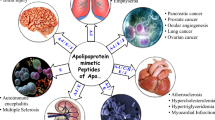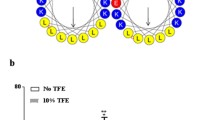Abstract
Apolipoprotein mimetic peptides are short synthetic peptides that have many of the same biological properties of ApoA-I, the main protein component of high-density lipoproteins (HDL). They have been shown to have beneficial effects in a wide variety of animal disease models, including atherosclerosis. One of the better understood properties of apolipoprotein mimetic peptides is their ability to promote the efflux of excess cellular cholesterol by the ABCA1 transporter and by other mechanisms. In this chapter, we will compare and contrast six different apolipoprotein mimetic peptides that are being investigated as possible therapeutic agents, particularly in regard to those features that are important in the cholesterol efflux process and in the overall reverse cholesterol transport pathway.
Access this chapter
Tax calculation will be finalised at checkout
Purchases are for personal use only
Similar content being viewed by others
References
Amar MJ et al (2010) 5A apolipoprotein mimetic peptide promotes cholesterol efflux and reduces atherosclerosis in mice. J Pharmacol Exp Ther 334(2):634–641
Anantharamaiah GM et al (1985) Studies of synthetic peptide analogs of the amphipathic helix. Structure of complexes with dimyristoyl phosphatidylcholine. J Biol Chem 260(18):10248–10255
Anantharamaiah GM et al (1990) Use of synthetic peptide analogues to localize lecithin: cholesterol acyltransferase activating domain in apolipoprotein A-I. Arterioscler Thromb Vasc Biol 10(1):95–105
Anantharamaiah GM et al (1991) Role of Amphipathic helixes in hdl structure-function. hypercholesterolemia, hypocholesterolemia, hypertriglyceridemia. Invivo Kinetics 285:131–140
Bielicki JK et al (2010) A new HDL mimetic peptide that stimulates cellular cholesterol efflux with high efficiency greatly reduces atherosclerosis in mice. J Lipid Res 51(6):1496–1503
Bloedon LT et al (2008) Safety, pharmacokinetics, and pharmacodynamics of oral apoA-I mimetic peptide D-4F in high-risk cardiovascular patients. J Lipid Res 49(6):1344–1352
Buga GM et al (2010) L-4F alters hyperlipidemic (but not healthy) mouse plasma to reduce platelet aggregation. Arterioscler Thromb Vasc Biol 30(2):283–289
Chorev M (2005) The partial retro-inverso modification: a road traveled together. Biopolymers 80(2–3):67–84
D’Souza W et al (2010) Structure/function relationships of apolipoprotein a-I mimetic peptides: implications for antiatherogenic activities of high-density lipoprotein. Circ Res 107(2):217–227
Dasseux J-L (2001) Peptide/lipid complex formation by co-lyophilization. US6287590 B1
Dasseux J-L et al (2003) Apolipoprotein A-I agonists and their use to treat dyslipidemic disorders. US20030008827 A1
Dasseux J-L et al (2004) Multimeric Apoa-I agonist compounds. US6753313 B1
Dasseux J-L et al (2006) Apolipoprotein A-I agonists and their use to treat dyslipidemic disorders. US 20060252694 A1
Dasseux J-L et al (2013) Apolipoprotein A-I mimics. US8378068 B2
Di Bartolo BA et al (2011a) The apolipoprotein A-I mimetic peptide ETC-642 exhibits anti-inflammatory properties that are comparable to high density lipoproteins. Atherosclerosis 217(2):395–400
Di Bartolo BA et al (2011b) The apolipoprotein A-I mimetic peptide, ETC-642, reduces chronic vascular inflammation in the rabbit. Lipids Health Dis 10:224
Du L et al (2013) Reverse apolipoprotein A-I mimetic peptide R-D4F inhibits neointimal formation following carotid artery ligation in mice. Am J Pathol 182(5):1932–1939
Esperion begins multiple-dose study of ETC-642 (RLT peptide) in patients with stable atherosclerosis (2003). Available from: http://www.prnewswire.co.uk/news-releases/esperion-begins-multiple-dose-study-of-etc-642-rlt-peptide-in-patients-with-stable-atherosclerosis-154589805.html
Getz GS et al (2010) Biological properties of apolipoprotein a-I mimetic peptides. Curr Atheroscler Rep 12(2):96–104
Handattu SP et al (2013) Two apolipoprotein E mimetic peptides with similar cholesterol reducing properties exhibit differential atheroprotective effects in LDL-R null mice. Atherosclerosis 227(1):58–64
Iwata A et al (2011) Antiatherogenic effects of newly developed apolipoprotein A-I mimetic peptide/phospholipid complexes against aortic plaque burden in Watanabe-heritable hyperlipidemic rabbits. Atherosclerosis 218(2):300–307
Khan M et al (2003) Single-dose intravenous infusion of ETC-642, a 22-Mer ApoA-I analogue and phospholipids complex, elevates HDL-C in atherosclerosis patients. Circulation 108(17):563–564
Kos reports on promising data presented at AHA: new compound reverse-D4F, a novel Apo A-I mimetic peptide, may reduce the progression of atherosclerosis (2005). Available from: http://www.businesswire.com/news/home/20051114005406/en/Kos-Reports-Promising-Data-Presented-AHA-Compound#.VF0-H_nF9HV
Krause BR et al (2013) Reconstituted HDL for the acute treatment of acute coronary syndrome. Curr Opin Lipidol 24(6):480–486
Laskowitz DT et al (2006) Apolipoprotein E-derived peptides reduce CNS inflammation: implications for therapy of neurological disease. Acta Neurol Scand Suppl 185:15–20
Meriwether D et al (2011) Enhancement by LDL of transfer of L-4F and oxidized lipids to HDL in C57BL/6J mice and human plasma. J Lipid Res 52(10):1795–1809
Miles JM et al (2004) Single-dose tolerability, pharmacokinetics, and cholesterol mobilization in HDL-C fraction following intravenous administration of ETC-642, a 22-mer ApoA-I analogue and phospholipids complex, in atherosclerosis patients. Proceedings of ATVB
Murase K et al (2014) Apo A-I mimetic peptides and methods of treatment. US8748394 B2
Navab M (2002) Oral administration of an Apo A-I mimetic peptide synthesized from D-amino acids dramatically reduces atherosclerosis in mice independent of plasma cholesterol. Circulation 105(3):290–292
Navab M et al (2004) Oral D-4F causes formation of pre-beta high-density lipoprotein and improves high-density lipoprotein-mediated cholesterol efflux and reverse cholesterol transport from macrophages in apolipoprotein E-null mice. Circulation 109(25):3215–3220
Navab M et al (2005a) Apolipoprotein A-I mimetic peptides. Arterioscler Thromb Vasc Biol 25(7):1325–1331
Navab M et al (2005b) D-4F and statins synergize to render HDL antiinflammatory in mice and monkeys and cause lesion regression in old apolipoprotein E-null mice. Arterioscler Thromb Vasc Biol 25(7):1426–1432
Nion S et al (1998) Branched synthetic peptide constructs mimic cellular binding and efflux of apolipoprotein AI in reconstituted high density lipoproteins. Atherosclerosis 141(2):227–235
Pfizer to drop development of drugs for hyperlipidemia, atherosclerosis, and heart failure. (2008). Available from: http://www.medscape.com/viewarticle/581528
Qin S et al (2012) Reverse D4F, an apolipoprotein-AI mimetic peptide, inhibits atherosclerosis in ApoE-null mice. J Cardiovasc Pharmacol Ther 17(3):334–343
Remaley AT (2013) Tomatoes, lysophosphatidic acid, and the small intestine: new pieces in the puzzle of apolipoprotein mimetic peptides? J Lipid Res 54(12):3223–3226
Remaley AT et al (2001) Apolipoprotein specificity for lipid efflux by the human ABCAI transporter. Biochem Biophys Res Commun 280(3):818–823
Remaley AT et al (2003) Synthetic amphipathic helical peptides promote lipid efflux from cells by an ABCA1-dependent and an ABCA1-independent pathway. J Lipid Res 44(4):828–836
Rosenson RS et al (2012) Cholesterol efflux and atheroprotection: advancing the concept of reverse cholesterol transport. Circulation 125(15):1905–1919
Rothblat GH et al (2010) High-density lipoprotein heterogeneity and function in reverse cholesterol transport. Curr Opin Lipidol 21(3):229–238
Rousset X et al (2011) Lecithin cholesterol acyltransferase: an anti- or pro-atherogenic factor? Curr Atheroscler Rep 13(3):249–256
Schwartz CC et al (2004) Lipoprotein cholesteryl ester production, transfer, and output in vivo in humans. J Lipid Res 45(9):1594–1607
Segrest JP et al (1990) Amphipathic helix motif: classes and properties. Proteins Struct Funct Bioinforma 8(2):103–117
Sethi AA et al (2007) Apolipoprotein AI mimetic peptides: possible new agents for the treatment of atherosclerosis. Curr Opin Investig Drugs 8(3):201–212
Sethi AA et al (2008) Asymmetry in the lipid affinity of bihelical amphipathic peptides. A structural determinant for the specificity of ABCA1-dependent cholesterol efflux by peptides. J Biol Chem 283(47):32273–32282
Shah PK et al (2005) Apolipoprotein A-I mimetic peptides: potential role in atherosclerosis management. Trends Cardiovasc Med 15(8):291–296
Smith LE et al (2013) Helical domains that mediate lipid solubilization and ABCA1-specific cholesterol efflux in apolipoproteins C-I and A-II. J Lipid Res 54(7):1939–1948
Sviridov DO et al (2013) Hydrophobic amino acids in the hinge region of the 5A apolipoprotein mimetic peptide are essential for promoting cholesterol efflux by the ABCA1 transporter. J Pharmacol Exp Ther 344(1):50–58
Tabet F et al (2010) The 5A apolipoprotein A-I mimetic peptide displays antiinflammatory and antioxidant properties in vivo and in vitro. Arterioscler Thromb Vasc Biol 30(2):246–252
Van Lenten BJ et al (2008) Anti-inflammatory apoA-I-mimetic peptides bind oxidized lipids with much higher affinity than human apoA-I. J Lipid Res 49(11):2302–2311
Vecoli C et al (2011) Apolipoprotein A-I mimetic peptide L-4F prevents myocardial and coronary dysfunction in diabetic mice. J Cell Biochem 112(9):2616–2626
Vedhachalam C et al (2007) The C-terminal lipid-binding domain of apolipoprotein E is a highly efficient mediator of ABCA1-dependent cholesterol efflux that promotes the assembly of high-density lipoproteins. Biochemistry 46(10):2583–2593
Watson CE et al (2011) Treatment of patients with cardiovascular disease with L-4F, an apo-A1 mimetic, did not improve select biomarkers of HDL function. J Lipid Res 52(2):361–373
Wool GD et al (2008) Apolipoprotein A-I mimetic peptide helix number and helix linker influence potentially anti-atherogenic properties. J Lipid Res 49(6):1268–1283
Xie Q et al (2010) D-4F, an apolipoprotein A-I mimetic peptide, promotes cholesterol efflux from macrophages via ATP-binding cassette transporter A1. Tohoku J Exp Med 220(3):223–228
Yao X et al (2011) 5A, an apolipoprotein A-I mimetic peptide, attenuates the induction of house dust mite-induced asthma. J Immunol 186(1):576–583
Ying R et al (2013) The combination of L-4F and simvastatin stimulate cholesterol efflux and related proteins expressions to reduce atherosclerotic lesions in apoE knockout mice. Lipids Health Dis 12:180
Zhao Y et al (2013) Mimicry of high-density lipoprotein: functional peptide-lipid nanoparticles based on multivalent peptide constructs. J Am Chem Soc 135(36):13414–13424
Acknowledgments
A.S. and D.L. were supported in part by AHA 13SDG17230049. Research by A.R. and S.G. were supported by intramural research funds from the National Heart, Lung, and Blood Institute.
Author information
Authors and Affiliations
Corresponding author
Editor information
Editors and Affiliations
Rights and permissions
Copyright information
© 2015 Springer International Publishing Switzerland
About this chapter
Cite this chapter
Li, D., Gordon, S., Schwendeman, A., Remaley, A.T. (2015). Apolipoprotein Mimetic Peptides for Stimulating Cholesterol Efflux. In: Anantharamaiah, G., Goldberg, D. (eds) Apolipoprotein Mimetics in the Management of Human Disease. Adis, Cham. https://doi.org/10.1007/978-3-319-17350-4_3
Download citation
DOI: https://doi.org/10.1007/978-3-319-17350-4_3
Publisher Name: Adis, Cham
Print ISBN: 978-3-319-17349-8
Online ISBN: 978-3-319-17350-4
eBook Packages: MedicineMedicine (R0)




